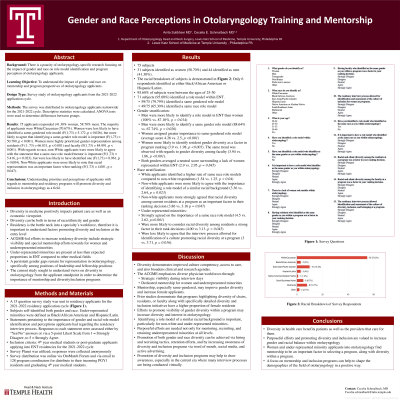Business of Medicine/Practice Management
(209) Gender and Race in Otolaryngology Training and Mentorship
Monday, October 2, 2023
2:45 PM - 3:45 PM East Coast USA Time


Anita Sulibhavi, MD
Resident
Temple University Hospital
Philadelphia, Pennsylvania, United States- CS
Cecelia Schmalbach, MD
Lewiz Katz School of Medicine at Temple University, USA
Presenting Author(s)
Senior Author(s)
Disclosure(s):
Anita Sulibhavi, MD: No relevant relationships to disclose.
Cecelia Schmalbach, MD: No relevant relationships to disclose.
Introduction: There is little otolaryngology-specific research focusing on the impact of gender and race on role model identification and program perception of otolaryngology applicants. The objective of this study was to understand the impact of gender and race on mentorship and program perspectives of otolaryngology applicants.
Methods: A survey study of otolaryngology applicants from the 2021-2022 application cycle was undertaken evaluating gender and racial identity, and attitudes towards representation and mentorship at otolaryngology residency programs based on residency interview experiences. The survey was distributed to otolaryngology applicants nationwide for the 2021-2022 cycle. Descriptive statistics were calculated. ANOVA tests were used to determine differences between groups.
Results: 75 applicants responded (41.30% women, 58.70% men). The majority of applicants were White/Caucasian (70.67%). Women were less likely to have identified a same-gendered role model (F(1,73) = 5.172, p = 0.026), but more likely to agree that identifying a same-gender role model is important (F(1,73) = 50.700, p < 0.001). Women more highly prioritized gender-representation among residents (F (1, 73) = 66.831, p < 0.001) and faculty (F(1,73) = 84.991, p < 0.001). With regards to race, non-White applicants were more likely to agree with the statement that a same-race role model/mentor is important (F(1,73) = 5.416, p = 0.023), but were less likely to have identified one (F(1,73) = 8.961, p = 0.004). Non-White applicants were more likely to note that racial representation was an important factor when ranking (F(1,73) = 4.081, p = 0.047).
Conclusions: Understanding priorities and perceptions of applicants with regards to mentorship and residency programs will promote diversity and inclusion in otolaryngology as a field.
